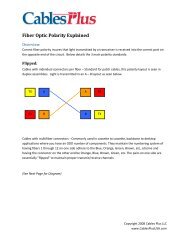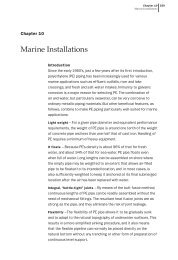Learning About Options in Fiber - Cables Plus USA
Learning About Options in Fiber - Cables Plus USA
Learning About Options in Fiber - Cables Plus USA
Create successful ePaper yourself
Turn your PDF publications into a flip-book with our unique Google optimized e-Paper software.
REFLECTION AND REFRACTION<br />
SECTION 1—INTRODUCTION TO FIBER<br />
Optical fiber transmits light by a law of physics<br />
known as the pr<strong>in</strong>ciple of total <strong>in</strong>ternal reflection.<br />
This pr<strong>in</strong>ciple was discovered by a British scientist<br />
named John Tyndall <strong>in</strong> the mid-1800s. He used it<br />
to demonstrate a way to conf<strong>in</strong>e light and actually<br />
bend it around corners. His experiments directed<br />
a beam of light out through a hole <strong>in</strong> the side of a<br />
bucket of water. He was able to demonstrate how<br />
the light was conf<strong>in</strong>ed to the curved stream of<br />
water, and how the water’s chang<strong>in</strong>g path redirected<br />
the path of light.<br />
Total <strong>in</strong>ternal reflection is even more efficient than<br />
mirrored reflection; it reflects more than 99.9<br />
percent of the light.<br />
Figure 1-1—Refraction and a Prism<br />
Refraction<br />
Refraction<br />
Red<br />
Orange<br />
Yellow<br />
Green<br />
Blue<br />
Violet<br />
The quantifiable physical property of a transparent<br />
material that relates to total <strong>in</strong>ternal reflection is its<br />
refractive <strong>in</strong>dex. Refractive <strong>in</strong>dex is def<strong>in</strong>ed as the<br />
ratio of the speed of light <strong>in</strong> a vacuum to the<br />
speed of light <strong>in</strong> a specific material.<br />
Light travels fastest through a vacuum. As it starts<br />
to travel through denser material, it slows down a<br />
little. What is commonly called the speed of light is<br />
actually the velocity of electromagnetic energy <strong>in</strong> a<br />
vacuum such as space. Light travels at slower<br />
velocities <strong>in</strong> other materials such as glass.<br />
Light travel<strong>in</strong>g from one material to another<br />
changes speed, which results <strong>in</strong> light chang<strong>in</strong>g its<br />
direction of travel. This deflection of light is called<br />
refraction. In addition, different wavelengths of<br />
light travel at different speeds <strong>in</strong> the same material.<br />
The variation of velocity with wavelength plays<br />
an important role <strong>in</strong> fiber optics.<br />
White light enter<strong>in</strong>g a prism conta<strong>in</strong>s all colors.<br />
The prism refracts the light and it changes speed<br />
as it enters. Because each wave changes speed<br />
differently, each is refracted differently. Red light<br />
deviates the least and travels the fastest. Violet<br />
light deviates the most and travels the slowest.<br />
The light emerges from the prism divided <strong>in</strong>to the<br />
colors of the ra<strong>in</strong>bow. As can be seen <strong>in</strong> Figure 1-1<br />
refraction occurs at the entrance and at the exit of<br />
the prism. The amount that a ray of light is refracted<br />
depends on the refractive <strong>in</strong>dices of the two materials.<br />
Figure 1-2 illustrates several important terms<br />
required to understand light and its refraction.<br />
Figure 1-2—Angles of Incidence and Refraction<br />
Interface<br />
Incident<br />
Ray<br />
Angle of<br />
Incidence<br />
is less than n 2<br />
n 1<br />
Normal<br />
Reflected<br />
Wave<br />
n 1<br />
n 2<br />
Angle of Refraction<br />
Refracted Ray<br />
• The normal is an imag<strong>in</strong>ary l<strong>in</strong>e perpendicular<br />
to the <strong>in</strong>terface of the two materials.<br />
• The angle of <strong>in</strong>cidence is the angle between<br />
the <strong>in</strong>cident ray and the normal.<br />
• The angle of refraction is the angle between<br />
the refracted ray and the normal.<br />
Light pass<strong>in</strong>g from a lower refractive <strong>in</strong>dex to a<br />
higher one is bent toward the normal. But light<br />
go<strong>in</strong>g from a higher <strong>in</strong>dex to a lower one refracts<br />
away from the normal, as shown <strong>in</strong> Figure 1-3.<br />
1-3
















